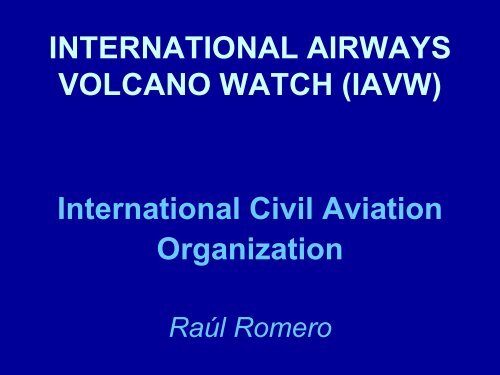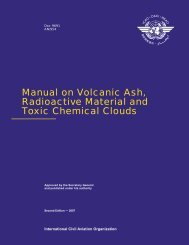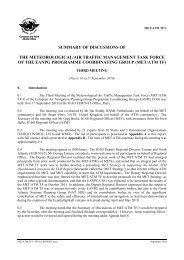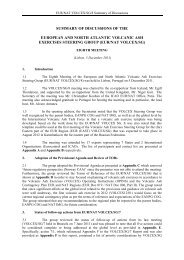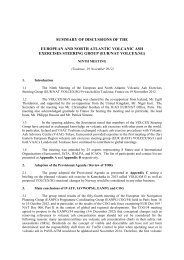INTERNATIONAL AIRWAYS VOLCANO WATCH (IAVW ...
INTERNATIONAL AIRWAYS VOLCANO WATCH (IAVW ...
INTERNATIONAL AIRWAYS VOLCANO WATCH (IAVW ...
You also want an ePaper? Increase the reach of your titles
YUMPU automatically turns print PDFs into web optimized ePapers that Google loves.
<strong>INTERNATIONAL</strong> <strong>AIRWAYS</strong><br />
<strong>VOLCANO</strong> <strong>WATCH</strong> (<strong>IAVW</strong>)<br />
International Civil Aviation<br />
Organization<br />
Raúl Romero
2<br />
SUMMARY<br />
• Introduction, Definition<br />
• Requirements<br />
• <strong>IAVW</strong>OPSG<br />
• Structure<br />
• Operation<br />
Detection<br />
Warning<br />
• Implementation issues<br />
• Latest developments<br />
• Challenges and future developments<br />
• Conclusion
3<br />
INTRODUCTION<br />
• 24 June 1982 , B747 from Kuala Lumpur<br />
to Perth lost power on all four engines at<br />
37000 ft, successfully landed at Jakarta.<br />
• Three weeks later, another B747 flying to<br />
Melbourne reported a similar incident,<br />
landed also at Jakarta.<br />
• Volcanic ash from Mt. Galunggung<br />
suspected as culprit.
4<br />
DEFINITION<br />
In accordance with Annex 3- Meteorological<br />
Service for International Air Navigation, to the<br />
Convention on International Civil Aviation<br />
International Airways Volcano Watch<br />
(<strong>IAVW</strong>).<br />
International arrangements for<br />
monitoring and providing warnings to<br />
aircraft of volcanic ash in the<br />
atmosphere.
5<br />
DEFINITION<br />
Note.— The <strong>IAVW</strong> is based on the<br />
cooperation of aviation and non-aviation<br />
operational units using information derived<br />
from observing sources and networks that<br />
are provided by States. The watch is<br />
coordinated by ICAO with the cooperation<br />
of other concerned international<br />
organizations.
6<br />
DEFINITION<br />
Volcanic ash advisory centre (VAAC).<br />
A meteorological centre designated by<br />
regional air navigation agreement to<br />
provide advisory information to<br />
meteorological watch offices, area control<br />
centres, flight information centres, world<br />
area forecast centres and international<br />
OPMET databanks regarding the lateral<br />
and vertical extent and forecast movement<br />
of volcanic ash in the atmosphere<br />
following volcanic eruptions.
Annex 3, 3.5.1<br />
7<br />
REQUIREMENTS<br />
VAAC- Volcanic Ash Advisory Centre<br />
Monitor relevant data to detect VA<br />
Activate models to forecast movement of ash clouds<br />
Issue advisory information to:<br />
MWOs, ACCs/FICs, other VAACs, WAFCs,databanks,<br />
NOFs, AFS distribution systems, airlines<br />
Issue updated information, as necessary<br />
24-hour watch
VAAC MODELS<br />
8<br />
REQUIREMENTS<br />
METEOSAT (MSG)<br />
MODIS<br />
G-BiRD<br />
VAFTAD<br />
CANERM<br />
MOCAGE<br />
PERLE<br />
HYSPLIT<br />
NAME<br />
PUFF
9<br />
REQUIREMENTS<br />
State volcano observatories<br />
Annex 3, 3.6<br />
Contracting States that maintain volcano observatories monitoring<br />
active volcanoes shall arrange that selected State volcano<br />
observatories, as designated by regional air navigation agreement,<br />
observing:<br />
a) significant pre-eruption volcanic activity, or a cessation thereof;<br />
b) a volcanic eruption, or a cessation thereof; and/or<br />
c) volcanic ash in the atmosphere<br />
shall send this information as quickly as practicable to its associated<br />
ACC, MWO and VAAC.
Annex 3, 3.4<br />
10<br />
REQUIREMENTS<br />
MWO- Meteorological Watch Office<br />
• maintain watch over meteorological conditions affecting flight<br />
operations within its area of responsibility;<br />
• a) prepare SIGMET and other information relating to its<br />
area of responsibility;<br />
• b) supply SIGMET information and, as required, other<br />
meteorological information to associated air traffic services units;<br />
• c) disseminate SIGMET information;<br />
• supply information received on pre-eruption volcanic activity, a<br />
volcanic eruption and volcanic ash cloud to its associated ACC/FIC,<br />
and to its associated VAAC as determined by regional air<br />
navigation agreement
11<br />
<strong>IAVW</strong>OPSG<br />
<strong>IAVW</strong> Operations Group<br />
Established in 2002 by the MET Divisional<br />
Meeting<br />
assists ICAO in the coordination and<br />
development of the <strong>IAVW</strong><br />
9 VAACs, IAEA, IATA, IFALPA, IUGG and<br />
WMO<br />
http://www.icao.int/anb/<strong>IAVW</strong>OPSG/
1. Terms of reference:<br />
<strong>IAVW</strong>OPSG<br />
The <strong>IAVW</strong>OPSG should:<br />
a) provide advice and guidance to the secretariat concerning the operation of the <strong>IAVW</strong> and its effectiveness in<br />
meeting current operational requirements;<br />
b) develop proposals for the development of the <strong>IAVW</strong> in order to ensure that it continues to meet evolving<br />
operational requirements;<br />
Note.— Such proposals for requirements should be made under ICAO procedures for the amendment of Annex 3.<br />
c) assist the Secretariat in the coordination of the arrangements between the various international organizations<br />
comprising the <strong>IAVW</strong>;<br />
d) coordinate with the SADISOPSG and WAFSOPSG regarding the inclusion of volcanic ash advisories and<br />
SIGMETs on the ICAO satellite broadcasts;<br />
e) assist the Secretariat in the development of appropriate guidance material both for operations with volcanic ash in<br />
the atmosphere and also operations with volcanic ash deposited on aerodromes;<br />
f) develop specific proposals for the provision of warnings for aerodrome management for deposition of volcanic ash<br />
on aerodromes;<br />
g) provide advice and guidance to the Secretariat and the VAACs regarding the future ICAO <strong>IAVW</strong> and existing<br />
VAAC Websites, respectively;<br />
h) provide advice to the Secretariat regarding the development of international arrangements for the provision of<br />
warnings to aircraft of radioactive materials and toxic chemicals in the atmosphere (legacy task of the VAWSG);<br />
and<br />
i) make regular progress reports to the Air Navigation Commission.<br />
2. Composition<br />
The <strong>IAVW</strong>OPSG should comprise representatives from States providing the VAACs, other user States that provided<br />
members to the VAWSG, and representatives from International Atomic Energy Agency (IAEA), International Air<br />
Transport Association (IATA), International Federation of Air Line Pilots’ Associations (IFALPA), International<br />
Union of Geodesy and Geophysics (IUGG) (covering the International Association of Volcanology and Chemistry<br />
12 of the Earth’s Interior (IAVCEI) and its commission the World Organization of Volcano Observatories (WOVO)),<br />
and World Meteorological Organization (WMO).
13<br />
STRUCTURE
14<br />
STRUCTURE
15<br />
STRUCTURE<br />
OBSERVING COMPONENT<br />
• Detection & tracking of VA clouds using<br />
Data from volcano observatories<br />
Satellite images<br />
Aircraft reports (special AIREP)<br />
Other sources
16<br />
STRUCTURE<br />
WARNING COMPONENT<br />
• Volcanic ash advisories by VAAC<br />
Role of Numerical Weather Prediction<br />
Models and WMO (Int. Workshops on<br />
VA)<br />
• SIGMET by MWO<br />
• NOTAM/ASHTAM by ACC<br />
VAACs, MWOs and ACCs, authorized<br />
aviation units for the provision of VA<br />
information to aviation
OPERATION<br />
Example A2-1. Advisory message for volcanic ash<br />
• VA ADVISORY<br />
• DTG:20000402/0700Z<br />
• VAAC:TOKYO<br />
• <strong>VOLCANO</strong>:USUZAN 805-03<br />
• PSN:N4230 E14048<br />
• AREA:JAPAN<br />
• SUMMIT ELEV:732M<br />
• ADVISORY NR:2000/432<br />
• INFO SOURCE:GMS JMA<br />
• AVIATION COLOUR CODE:RED<br />
• ERUPTION DETAILS:ERUPTED 20000402/0614Z ERUPTION OBS VA TO ABV FL300<br />
• OBS VA DTG:02/0645Z<br />
• OBS VA CLD:FL150/350 N4230 E14048 – N4300 E14130 – N4246 E14230 – N4232 E14150 –<br />
N4230 E14048 SFC/FL150 MOV NE 25KT FL150/350 MOV E 30KT<br />
• FCST VA CLD +6 HR:02/1245Z SFC/FL200 N4230 E14048 – N4232 E14150 – N4238 E14300 –<br />
N4246 E14230 FL200/350 N4230 E14048 – N4232 E14150 – N4238 E14300 – N4246 E14230<br />
FL350/600 NO VA EXP<br />
• FCST VA CLD +12 HR:02/1845Z SFC/FL300 N4230 E14048 – N4232 E14150 – N4238 E14300 –<br />
N4246 E14230 FL300/600 NO VA EXP<br />
• FCST VA CLD +18 HR:03/0045Z SFC/FL600 NO VA EXP<br />
• RMK:VA CLD CAN NO LONGER BE DETECTED ON SATELLITE IMAGE<br />
17 • NXT ADVISORY:20000402/1300Z
18<br />
OPERATION
OPERATION<br />
Example A6-3. SIGMET message for volcanic ash<br />
• YUDD SIGMET 2 VALID 211100/211700 YUSO –YUDD SHANLON FIR/UIR VA<br />
ERUPTION MT ASHVAL LOC S1500 E07348 VA CLD OBS AT 1100Z FL310/450<br />
APRX 220KM BY 35KM S1500 E07348 - S1530 E07642 MOV SE 65KMH FCST<br />
1700Z VA CLD APRX S1506 E07500 - S1518 E08112 - S1712 E08330 - S1824<br />
E07836<br />
• Meaning: The second SIGMET message issued for the SHANLON* flight information<br />
region (identified by YUDD Shanlon area control centre/upper flight information<br />
region) by the Shanlon/International* meteorological watch office (YUSO) since 0001<br />
UTC; the message is valid from 1100 UTC to 1700 UTC on the 21st of the month;<br />
volcanic ash eruption of Mount Ashval* located at 15 degrees south and 73 degrees<br />
48 minutes east; volcanic ash cloud observed at 1100 UTC between flight levels 310<br />
and 450 in an approximate area of 220 km by 35 km between 15 degrees south and<br />
73 degrees 48 minutes east, and 15 degrees 30 minutes south and 76 degrees 42<br />
minutes east; the volcanic ash cloud is expected to move southeastwards at 65<br />
kilometres per hour; at 1700 UTC the volcanic ash cloud is forecast to be located<br />
approximately in an area bounded by the following points: 15 degrees 6 minutes<br />
south and 75 degrees east, 15 degrees 18 minutes south and 81 degrees 12 minutes<br />
east, 17 degrees 12 minutes south and 83 degrees 30 minutes east, and 18 degrees<br />
24 minutes south and 78 degrees 36 minutes east.* Fictitious locations<br />
19
20<br />
OPERATION
21<br />
OPERATION<br />
Guidance Material<br />
Handbook on the <strong>IAVW</strong>, Operational<br />
Procedures and Contact List, Doc 9766<br />
(http://www.icao.int/icaonet/dcs/9766/ )<br />
Manual on Volcanic Ash, Radioactive<br />
Material and Toxic Chemical Clouds, Doc<br />
9691<br />
ICAO and IFALPA videos, posters, USGS<br />
maps
23<br />
IMPLEMENTATION ISSUES<br />
Delayed notification<br />
Lack of timely info on volcanic eruptions<br />
Lack of implementation of SIGMET<br />
(issuance, format, dissemination)<br />
Limited skills in forecasting VA<br />
dispersion<br />
Eruption Source Parameters (ESP) as a tool
24<br />
CHALLENGES AND FUTURE<br />
DEVELOPMENTS
25<br />
CHALLENGES AND FUTURE<br />
DEVELOPMENTS<br />
Leading-edge deposits dislodged during disassembly of stage-1 high-pressure-turbine<br />
nozzle guide vanes
26<br />
CHALLENGES AND FUTURE<br />
DEVELOPMENTS
27<br />
CHALLENGES AND FUTURE<br />
DEVELOPMENTS<br />
• Early notification (specially for nonmonitored<br />
volcanoes)<br />
Infrasonics (ASHE, CTBTO)<br />
• SIGMET issue (consolidation of the<br />
issuance of SIGMETs, functional airspace<br />
blocks, systems interoperability ( e.g.<br />
XML))<br />
MET Divisional Meeting (2014)<br />
• Issue of “ safe” concentration on volcanic<br />
ash<br />
From scientific and industry viewpoint
28<br />
CHALLENGES AND FUTURE<br />
• SAFETY<br />
DEVELOPMENTS<br />
• MINIMUM RE-ROUTING OF<br />
AIRCRAFT<br />
• MINIMUM AICRAFT EXPOSURE TO<br />
NON-VISIBLE VOLCANIC ASH
29<br />
CONCLUSION<br />
“ GIVEN THE SAFETY AND<br />
ECONOMICS IMPLICATIONS OF<br />
VOLCANIC ASH TO AIRCRAFT<br />
OPERATIONS, IT IS NECESSARY<br />
TO MAINTAIN THE ICAO <strong>IAVW</strong> IN<br />
CONSTANT READINESS BUT WITH<br />
THE FERVENT HOPE THAT IT<br />
RARELY HAS TO BE USED”


